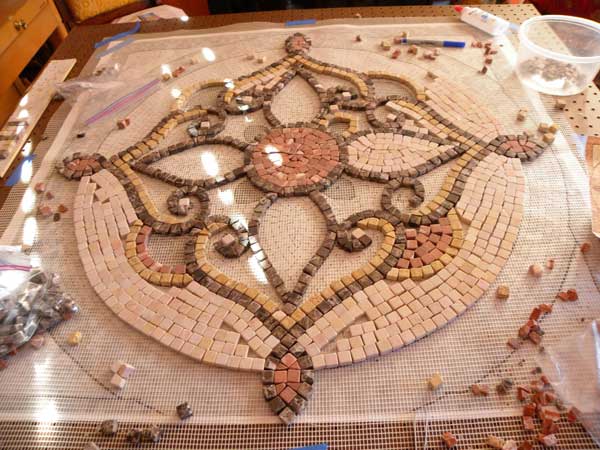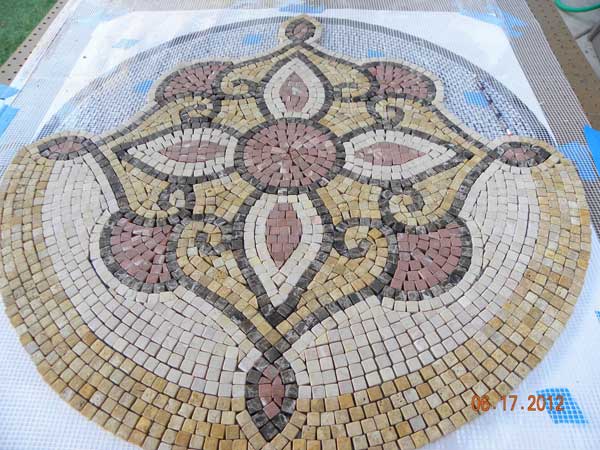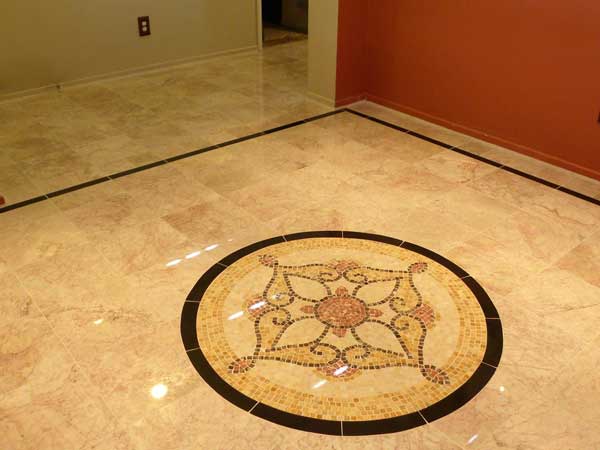Contemporary floor mosaics usually take the form of accents such as mosaic medallions and mosaic borders instead of the larger pictoral designs that covered the entire floors of ancient Roman houses. The contemporary mosaic accents are integrated with the existing flooring material, which is usually larger tiles of marble or ceramic. These limited area designs are more practical for the simple reason that most of the floor is covered with furniture, and it only makes sense to mosaic the small part of the floor where it will be consistently visible. That being said, I would absolutely love to have a customer email me pictures of a full floor design.
Mosaic Medallion
The mosaic below is a beautiful example of a compass rose medallion made by our customer Caroline Lahman from the tumbled marble mosaic we sell. I’m particularly impressed with the professional quality of the work Caroline did, and the fact that she actually took the time to photo-document the work in progess with publication-quality images, which is something I usually fail to do once I get rolling.

The first step in making a mosaic medallion is to draw a pattern and tape it to a work table and cover the pattern with construction plastic or plastic kitchen wrap so that you don’t glue everything to your pattern. On top of this, fiberglass mesh is laid and the corners taped or tacked down securely. Although the pattern should be visible through the mesh, I find it useful to take a Sharpie brand marker and trace the design on the mesh directly just to make sure I can see it once things get a little messy.

For most floors, water isn’t that much of an issue, but for shower floor and bathroom floor mosaics, it is something to think about. For these “wet” mosaics, I like to use only a drop of glue at the center of the tile when I attach it to the mesh. This leaves some of the tile uncovered by glue so that it can bond directly to the thinset mortar when the finished mosaic is mounted to the floor. The thinset mortar is much more water resistant than white PVA glues such as Weldbond. (That being said, Weldbond is fairly water resistant when fully cured.)

Thinset mortar and grout are both concrete products that can stain porous materials like unpolished stone. To prevent this, the mosaic should be sealed before you grout it (and probably before you mount it because accidents can happen during mounting). The catch is that you don’t want to seal any surface where grout will need to bond, including the sides of the tiles. You only want to seal the top face of the stones. To do this, I use a small artist’s paint brush and carefully brush the sealer on the top face of the stone taking care to not let excess sealer run into the gaps between the stones. I use TileLab brand “Grout & Tile Sealer” for a normal seal. I use TileLab brand “Stone Enhancer & Sealer” if I want to slightly enhance/darken the stone colors (recommended). Both of these are available at Home Depot. Note that these products are invisible pore sealers and not an actual coating like polyurethane.

The finished compass rose medallion is well integrated with existing floor and the color scheme of the room. Congratulations Caroline on the job well done!
 The first step in making a mosaic medallion is to draw a pattern and tape it to a work table and cover the pattern with construction plastic or plastic kitchen wrap so that you don’t glue everything to your pattern. On top of this, fiberglass mesh is laid and the corners taped or tacked down securely. Although the pattern should be visible through the mesh, I find it useful to take a Sharpie brand marker and trace the design on the mesh directly just to make sure I can see it once things get a little messy.
The first step in making a mosaic medallion is to draw a pattern and tape it to a work table and cover the pattern with construction plastic or plastic kitchen wrap so that you don’t glue everything to your pattern. On top of this, fiberglass mesh is laid and the corners taped or tacked down securely. Although the pattern should be visible through the mesh, I find it useful to take a Sharpie brand marker and trace the design on the mesh directly just to make sure I can see it once things get a little messy.
 For most floors, water isn’t that much of an issue, but for shower floor and bathroom floor mosaics, it is something to think about. For these “wet” mosaics, I like to use only a drop of glue at the center of the tile when I attach it to the mesh. This leaves some of the tile uncovered by glue so that it can bond directly to the thinset mortar when the finished mosaic is mounted to the floor. The thinset mortar is much more water resistant than white PVA glues such as Weldbond. (That being said, Weldbond is fairly water resistant when fully cured.)
For most floors, water isn’t that much of an issue, but for shower floor and bathroom floor mosaics, it is something to think about. For these “wet” mosaics, I like to use only a drop of glue at the center of the tile when I attach it to the mesh. This leaves some of the tile uncovered by glue so that it can bond directly to the thinset mortar when the finished mosaic is mounted to the floor. The thinset mortar is much more water resistant than white PVA glues such as Weldbond. (That being said, Weldbond is fairly water resistant when fully cured.)
 Thinset mortar and grout are both concrete products that can stain porous materials like unpolished stone. To prevent this, the mosaic should be sealed before you grout it (and probably before you mount it because accidents can happen during mounting). The catch is that you don’t want to seal any surface where grout will need to bond, including the sides of the tiles. You only want to seal the top face of the stones. To do this, I use a small artist’s paint brush and carefully brush the sealer on the top face of the stone taking care to not let excess sealer run into the gaps between the stones. I use TileLab brand “Grout & Tile Sealer” for a normal seal. I use TileLab brand “Stone Enhancer & Sealer” if I want to slightly enhance/darken the stone colors (recommended). Both of these are available at Home Depot. Note that these products are invisible pore sealers and not an actual coating like polyurethane.
Thinset mortar and grout are both concrete products that can stain porous materials like unpolished stone. To prevent this, the mosaic should be sealed before you grout it (and probably before you mount it because accidents can happen during mounting). The catch is that you don’t want to seal any surface where grout will need to bond, including the sides of the tiles. You only want to seal the top face of the stones. To do this, I use a small artist’s paint brush and carefully brush the sealer on the top face of the stone taking care to not let excess sealer run into the gaps between the stones. I use TileLab brand “Grout & Tile Sealer” for a normal seal. I use TileLab brand “Stone Enhancer & Sealer” if I want to slightly enhance/darken the stone colors (recommended). Both of these are available at Home Depot. Note that these products are invisible pore sealers and not an actual coating like polyurethane.
 The finished compass rose medallion is well integrated with existing floor and the color scheme of the room. Congratulations Caroline on the job well done!
The finished compass rose medallion is well integrated with existing floor and the color scheme of the room. Congratulations Caroline on the job well done!